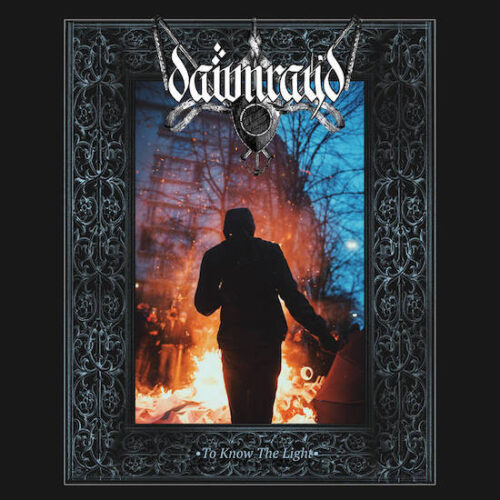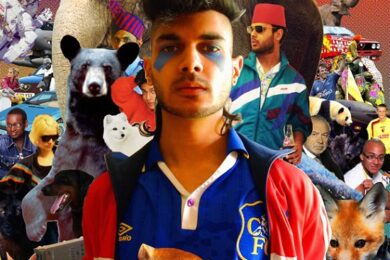Ashamedly late to the party, I only found out that patten had signed to Warp last month, and the news was electrifying. This is an artist I’ve followed for years, but I’d not realised until it happened quite how exciting a fit Warp – land of all the founding fathers, Aphex Twin, Autechre, Squarepusher, Boards Of Canada, Prefuse 73 and more – would be for him. ESTOILE NAIANT, his first outing on the preeminent electronic music label, is pure proof that he is indeed home. Released in February, this collection of ten tracks is at once tight and skittish, an exuberant, scintillating album of shifting layers, skidding beats and sounds that expand the space around your ears, in as many directions as you’re willing to head in. The sense of potential here is thrilling.
‘Drift’, the third track, is an epic, expansive ride, with Boards Of Canada-esque warmth and space, but something of Squarepusher’s exhilarating energy. The sounds keep rolling in in ever-widening bursts, with gorgeous drops allowing for atmospheric reverb, and suddenly it’s done. Following piece ‘Winter Strobing’ brings to mind the magic of early Mego, while the album’s last track ‘LL2’ is freeform abstraction comprising waves of hiss and froth and bulbous echo, a bit like Toshiya Tsunoda’s field recordings of the sea and the wind through a rusted metal drum or length of plastic pipe. But where Tsunoda works within the strict confines of a quasi-scientific method of collating and archiving found sounds, patten wields his own with wide-eyed buoyancy and creative enthusiasm.
patten – always lowercase – has come to the fore of the underground London scene on a slow and steady rise. His output has been restrained: two self-released limited CDRs, Sketching The Tesseract and There Were Horizons, in 2007 and 2008 respectively, followed by a first official album, GLAQJO XAACSSO, on No Pain in Pop in 2011. While his sound might be hard to pinpoint or categorise, it is precisely that sense of freedom that makes him a distinctive voice; unbridled curiosity and far-flung influences, along with an undying willingness to mix things up, be it in recordings or live, make him a reliably surprising figure. Live he has done everything from working with a full band featuring multiple keyboards and guitars playing everything through a chorus pedal, so as to give the whole a worn-out vinyl feel, to solo live-sampling of household objects, percussion, voice, electric guitar and other small instruments, to tight-knit laptop-only sessions.
On record, his compositions have a similar exploratory restlessness – you get the sense that patten could take the most inconsequential sound and find some way of making it shine. That said, there are certain driving constants to his music – a love of weather-worn, washed-up, bleached-out sounds; rhythms that are decidedly off-kilter, leaving you unsure whether things are speeding up or slowing down; and mostly, a way of stacking and building and meshing together layers of sound wherein more, and not less, is always better and no amount is too much, even when the density threatens to bring the whole thing crashing down. He rides a fine line between complexity and chaos, but with such dexterity and lightness of touch, with such soulfulness, that listening is always a pleasure, never a chore. You don’t just want to sit down and focus on it all, you want to dance.
The Quietus met with him on a recent rainy afternoon in Shoreditch to talk about new sounds, naming albums and how not being able to see is sometimes the best way forward.
‘Drift’
What can you tell me about the title of this new album, ESTOILE NAIANT?
patten: It’s a term I produced using Heraldic Blazon, the formal language of heraldry, which describes the elements forming a coat of arms. It is a way of precisely describing visual information through entirely linguistic means. So in a sense the terms themselves are images. The term "estoile naiant" translates as "star swimming horizontally", and refers to the sun reflected in a body of water. It is a way for me into looking at what this record could be and what all records and music could be. There’s something in there that opens up to the idea of a connection between the absolutely quotidian, here, now, everyday, individual experiences and something unfathomably large and universal. Something almost predating time. Predating anyone alive today and existing long after we are all gone. It’s all of our histories as people living, working some things out, writing, talking, singing, leaving these traces for those left to continue it all after we die. It’s a big project we’re all a part of. It’s the strange core of what it is to be human.
In the titles of albums/songs and the way you use words and letters on your website, there’s a distinct feeling of something coded, hidden, embedded even. Do you approach text in the same way as you approach sound?
p: As with the music itself, I hope to use language in such a way as to open creative possibilities for people who come into contact with the work. The titles are an invitation for people to engage in their own thought without boundaries or restrictions. I hope all of the work can embody this drive, this deep awe and strong belief in the possibility held within freedom of thought.
When did you finish ESTOILE NAIANT?
p: The material that comprises the album is part of a continuum that is always unfolding. So rather than talking of an album being finished, I would say it’s kind of a punctuation mark. As we talk now, it continues. As someone who I’ll never speak to listens to it in two weeks’ time, it continues. As a record becomes scratched or warps, the sound changes and it continues. As it’s placed on a mixtape, it continues. As it soundtracks the moments of someone’s afternoon or evening, it carries on. In all sorts of ways, it’s something that doesn’t finish, or begin.
Listening to these ten tracks, I’m struck by how visual, tangible even, the music feels. In trying to describe it, I find myself reaching for textures and patterns, words like torn paper, sand, confetti, a kaleidoscope…
p: It’s always interesting to me to hear the kinds of references that people listening to the work pick out or highlight. Conversations like this bring new perspectives and enable me to reacquaint myself with the ongoing project. I’m genuinely surprised at the way people describe the work. I don’t hear it in the same way. I guess it’s the same for anyone making something – you can’t experience it as someone else would. My intention isn’t to make difficult or incomprehensible music. I’m trying to make something that is open, trying to reach spaces that are open to unbounded exploration.
‘Drift’ is an exciting track. It brings to mind Bjork’s Debut, not that it sounds in any way similar, but in the sense that it is so rich in ideas and potential: it’s like a statement of intent or an inventory of sorts, not linear, but rhizomatous – you could go in a thousand directions from here.
p: Sometimes the unknown or the unfamiliar can be frightening to people, it can sound like opacity, whereas my intention is absolutely the opposite. Not being linear is important to me – a certain multidimensional quality, something that has space around it, and that you can turn around, stretch, manipulate into different forms just by engaging with it. I want to place these materials out in the world, and open up creative activity for the person on the other end, the listener who is investigating the work.
So you see putting your music out there to be listened to as a collaboration?
p: Yeah, definitely. Even making the work I see as a collaborative process, in the sense that I’m always trying to move past the self, to get past the restrictions of my own imagination, past who I am in 2014 as a person with a set of understandings and thoughts, likes and dislikes – it’s not that I think there’s anything wrong with someone being completely tuned into themselves and describing that inner world. But one of the things I’m trying to do is engage in direct dialogue with what it means to be a person, to find yourself in the world with all of this material to work your way through. At the same time I’m not talking about an inhuman or mechanical approach, but rather one that would leave behind those rigid boundaries that are part of one’s self, and work in a different manner.
There’s another analogy that works. You know the way a scent can be so specific and so intangible at the same time? Today on the way to the interview, I don’t know what it was, but I came across a very specific car smell and my senses were instantly transported to this kind of wormhole. But as soon as I became aware of the location of the smell – this kind of hyper-specific laser-sharp point – I was at once unable to place it. It began to evaporate. It’s like when you open an orange – such a strong and specific odour, yet you can’t catch or follow it. It’s so fleeting.
If you are trying to get away from boundaries or things that are set, does that mean, for example, that if you like a certain sound, you’ll stop yourself from going back to it?
p: Definitely. Even live – this evening I’m playing Rough Trade East, and I’ve kind of damaged my set. I’ve changed something quite fundamental in the mechanics of it. It didn’t work this morning, but hopefully it will later. When I say work, I mean that literally – technically, my computer just couldn’t handle it. I’m always trying to break habits and create situations that may allow for open trajectories to be followed and split from and folded back on themselves. In the process of composing, sometimes something appears to be worthwhile, and something else just seems a waste of time. But I try not to be led by either way of thinking. The thing that has value might be worth destroying. And the thing that seems worthless might be what needs to be left alone. Maybe I just can’t see it yet. Practically that involves all sorts of different things. Constantly shifting the way something is performed live means that there’s always the potential to discover new avenues that the work can go down.
‘Towards Infinite Shores’
Do you think of performances rather as happenings than recitals?
p: It’s more like we’re looking at it, in a certain scenario. Some of the things that change are what I’m doing, but there are also environmental changes – the sound system, how light it is, how bright it is, how loud it is, how people respond or don’t respond. All those elements are a kind of orchestra that perform with, against, across and beside each other, in an investigation of a moment in time.
When you perform live these days, do you play with other people or not?
p: Always solo currently, though there are no rules to say that this couldn’t change in the future. At the moment it is set up in such a way as to provide as much compositional freedom as possible live, though of course there are different freedoms afforded by solo and ensemble approaches to live performance. It’s all flexible and open to change as the project goes on. It always has been and will definitely continue with this flexibility and openness at its core.
Is improvisation important to you?
p: There are lots of words that that have very specific connotations and histories associated with them. Not that that makes them off limits. Working in the moment and dealing with the situation as it unfolds is definitely an important aspect of the way I function, both in the composition process and in playing live. Responding to the present in a dynamic way, as it unfolds, is crucial. But I don’t know that I would use the term "improvisation" to talk about this project.
I mean, for sure, when I’m performing or writing or any of these things, there’s a sense of stepping into the unknown. But then on the other hand, isn’t that what we all do all the time in life? What is not improvisation? Sometimes we have a sense of what we think might happen. If I pick up this glass, I think that it will lift up and gravity will still work the way I thought it did. But sometimes things work very differently to how you would expect them to. This morning I was holding a pair of scissors in my hand, and I put my glasses on, and the scissors kind of touched my eye. They were closed, but I kind of suddenly realised oh, I almost just poked my eye out. So you really don’t know how things are going to turn out. You could just be putting your glasses on, and end up half-blind. There’s actually something quite funny about that too – the idea of putting on your glasses and becoming blind…
Sometimes to see clearly, it can be useful to defocus one’s eyes. There are certain vantage points that are afforded by a sideways or diagonal glance, by blurring your vision, by being too close. Sometimes a magnifying glass will obscure your vision.
I asked about improvisation because I was surprised that your album was making me think of Fenn O’Berg, which isn’t a very current reference – as amazing as that music was at the time, it’s not something I’ve thought about for ages, and it feels almost passé. It’s not that yours sounds that theirs did, but there’s something about the layers of textures and the elation in the music that is similar.
p: Mego musicians like Peter Rehberg and Christian Fennesz were making music that didn’t exist. Laptop music was a genre then, which now just seems unimaginable. Saying "I really like laptop music" seems ridiculous now, and they probably hated the term, but it did mean something at the time. They were working in a space that didn’t have the same level of fixity that we might associate with electronic music now – there were no rules, and that lent the music a certain vitality. It’s very joyful. I really hope that my music can contain some kind of emotional resonance. The term "laptop music" can sound quite mechanistic or inhuman. But for me, all those musicians you brought up – Björk, Fennesz, Rehberg – as well as early dub music, the strangeness, the intensity that is held within those 7" dub records, or early house music, or even something like Sebadoh in the beginning – encased in all of this is a vitality, a sense of the alive, the unrestricted, the free, the human.
patten’s ESTOILE NAIANT is out now via Warp


















